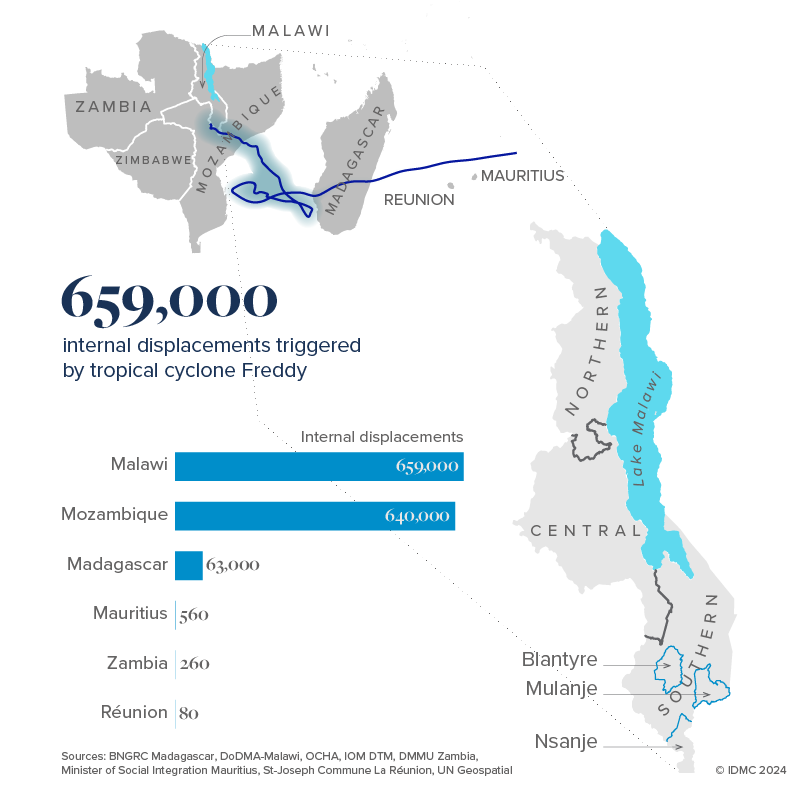
Spotlight
14 May 2024
Malawi - Cyclone Freddy puts disaster risk management to the test
Tropical Cyclone Freddy formed in the Indian Ocean on 5 February 2023 and sustained cyclonic conditions until it dissipated in Malawi on 14 March, making it one of the longest-lasting cyclones ever recorded worldwide. It was also exceptional in terms of intensity, becoming the third deadliest storm on record in the southern hemisphere. Freddy triggered 1.4 million internal displacements across six countries and territories in south-eastern Africa, twice as many as Cyclone Idai in 2019. More than 659,000 were recorded in landlocked Malawi, the highest figure since disaster displacement data became available for the country in 2009.
Malawi’s Department of Climate Change and Meteorological Services activated its early warning protocols a week before the storm’s arrival, disseminating information to communities at risk and encouraging them to seek safety elsewhere, move to higher ground and avoid river basins. These measures enabled some communities to use displacement as a life-saving strategy, but the cyclone’s impact exceeded the coping capacity of many who lost their homes and livelihoods.
Displacements were reported in the Southern region, particularly in the districts of Nsanje, Mulanje, Phalombe, Chikwawa, Zomba and Blantyre. Most took place in the first two districts, which were still recovering from the impacts of Tropical Storm Ana and Cyclone Gombe in 2022. Roads, bridges and power supplies in these predominantly rural areas were extensively damaged, hindering the delivery of food and other types of assistance to remote communities, some of which had to be accessed by helicopter. Crop damages and losses were lower than expected, but the cyclone contributed to worsening food insecurity.
Fewer displacements were recorded in Blantyre, but mud and landslides caused a higher death toll. After weeks of heavy rain, Freddy triggered structural failures in the soil and the fragile buildings on the hillsides of the urban area of Blantyre city, causing significant housing destruction and impeding the return of those displaced. Deforestation and the construction of informal settlements on slopes heightened the risk of mud and landslides, something that was not contemplated in Malawi’s previous disaster risk management strategy, which focused more on flood prevention and risk reduction.
As hundreds of thousands of homes were damaged or destroyed, authorities established emergency camps. Most were decommissioned by mid-October, but an estimated 26,000 people were still displaced by the end of the year. The government, in collaboration with international organisations, supported IDPs’ return or relocation by providing cash assistance and non-food items.
Freddy’s impacts were in many ways exceptional, but weather-related disasters have affected Malawi regularly in recent years. This has prompted the government to increase its efforts to build resilience and reduce disaster displacement risk. In terms of legal and policy frameworks, it passed the Disaster Risk Management Act a month after Freddy hit, placing greater emphasis on early warning, prevention and risk reduction, as well as response and recovery.
It also updated its disaster risk management system plans, assigning roles and responsibilities to conduct a multi-hazard risk assessment to prevent reconstruction in areas most frequently affected by disasters and, when necessary, relocate people to safer areas. The act also details the process of pre-emptive evacuations, including reference to a maximum duration for emergency shelters. This should allow for better monitoring of the length of displacement.
These initiatives are timely given that the frequency and intensity of cyclones are projected to increase in the region. Regional collaboration through data sharing and technical support could also further improve disaster risk management and responses to displacement.
For references and additional information, please see the full report.
